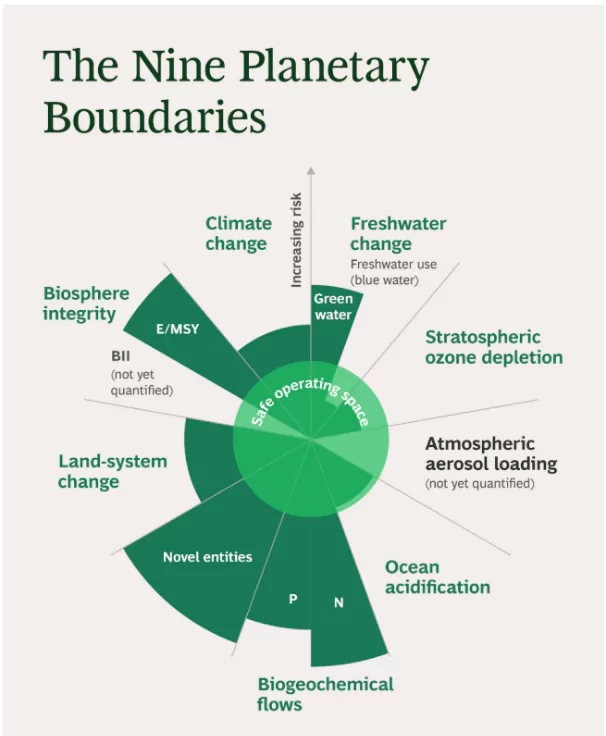A new study reveals that ocean acidification has already crossed its planetary boundary, posing a critical risk to marine ecosystems and the global environment.
About Ocean Acidification
- Ocean acidification refers to a reduction in the pH of the ocean over an extended period of time, caused primarily by uptake of carbon dioxide (CO2) from the atmosphere.
- It is often referred to as the “evil twin” of climate change.
What are Planetary Boundaries?
- The planetary boundaries are the natural limits of key global systems such as climate, water and wildlife diversity beyond which their ability to maintain a healthy planet is in danger of failing.
- It is developed by the Stockholm Resilience Centre.

|
Mechanism of Ocean Acidification
- Ocean acidification is caused by the absorption of excess atmospheric CO₂ by seawater.
- The dissolved CO₂ reacts with water to form carbonic acid (H₂CO₃).
- Carbonic acid dissociates into hydrogen ions (H⁺) and bicarbonate (HCO₃⁻), increasing ocean acidity.
- The increase in H⁺ ions reduces ocean pH, making it more acidic.
- H⁺ ions combine with carbonate ions (CO₃²⁻), forming more bicarbonate and reducing carbonate availability.
- Reduced carbonate ions limit the ability of marine organisms to form calcium carbonate (CaCO₃) shells and skeletons.
- This disrupts marine ecosystems, threatening biodiversity and global seafood security.
Effects of Ocean Acidification
- Alteration Of Ocean Chemistry: Oceans act as a Carbon Sink and absorb about 30% of atmospheric CO₂. With rising CO₂ emissions, oceanic absorption also increases, altering ocean chemistry.
Global Ocean Acidification Observing Network (GOA-ON)
- GOA-ON is a collaborative international network designed to address three goals:
- to improve our understanding of global OA conditions;
- to improve our understanding of ecosystem response to OA;
- to acquire and exchange data and knowledge necessary to optimize modelling for OA and its impacts.
- Supported by major bodies like: UNESCO-IOC (Intergovernmental Oceanographic Commission), IAEA (International Atomic Energy Agency), NOAA (National Oceanic and Atmospheric Administration).
|
- Harm to Calcifying Organisms: Acidification makes it harder for calcifying organisms such as oysters, clams etc to build and maintain their structures.
- Change in Ocean Stratification: Deeper waters of the ocean are changing more drastically than surface layers, affecting tropical and deep-sea coral reefs, essential for biodiversity.
- Impact on Non-Calcifying Organisms: Acidic waters impair fish behavior, especially their ability to detect predators.
- Behavioral changes in key species can destabilize the marine food web.
-
-
- Corals, molluscs, and shellfish face slower growth, and reduced reproductive success.
- Risk to Marine-Based Economies: Countries heavily dependent on fisheries and aquaculture are especially vulnerable.
- Decline in shellfish harvests, coral reef tourism, and marine biodiversity leads to job losses, reduced incomes etc.
- Food Security Risk: Ocean acidification threatens Fish stocks, Nutritional quality of seafood etc.
Climate Change and Ocean Acidification:
- Climate change, driven by rising CO₂ levels, leads to both global warming and ocean acidification.
- Oceans act as a carbon sink, absorbing nearly 30% of atmospheric CO₂, which reacts with seawater to form carbonic acid, thereby lowering pH.
- This process makes oceans increasingly acidic, disrupting marine ecosystems and life.
|
Key Findings of the Study on Ocean Acidification by Plymouth Marine Laboratory, NOAA and Oregon State University:
- Assessment: The study is based on 150 years of data, combining ice cores, chemical measurements, advanced modelling, and biological surveys.
- Planetary Boundary Crossed by 2020: The global average ocean condition breached the planetary boundary for acidification in or around 2020.
- The Planetary Boundary was defined as a >20% reduction in calcium carbonate availability compared to pre-industrial levels.
- Deep Ocean Conditions Are Worse: At 200 metres depth, 60% of global ocean waters have already crossed the acidification threshold.
- Most marine biodiversity exists below the surface, meaning impacts are more severe than surface-level data suggests.
- Widespread Ecosystem Risk: Species that depend on calcium carbonate, such as corals, mussels, oysters, and sea butterflies, are increasingly unable to maintain shells and structures.
- This results in weaker shells, reduced growth, lower reproduction, and higher mortality rates.
-
- Regional Variability: Some ocean regions breached the safe limit earlier than others, suggesting the need for region-specific conservation strategies.
- Solution: The authors underlined that decreasing CO2 emissions was the only way to deal with acidification globally, but that conservation measures could and should focus on the regions and species that were most vulnerable.
![]() 11 Jun 2025
11 Jun 2025

